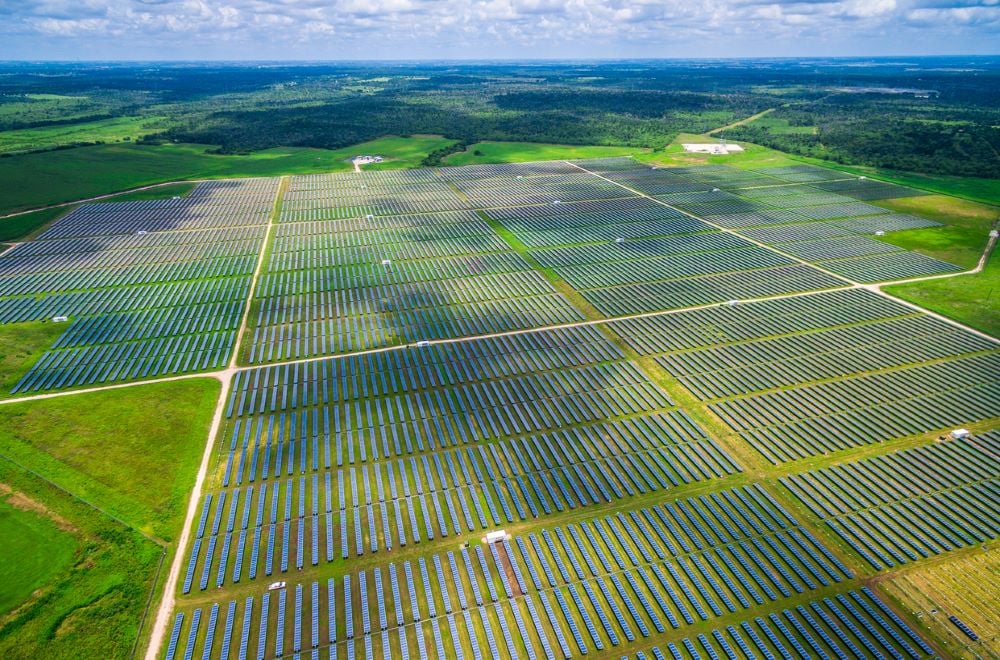Inverters and tracking systems account for a large portion of the hardware costs in a solar PV project. They also have a major bearing on the cost and performance of the site's SCADA system.
Let's start with the basics of SCADA system function, performance and cost, then dive into inverters and trackers specifically.
What is a SCADA system?
SCADA stands for Supervisory Control and Data Acquisition. It is the overall system by which operators monitor and control all of the different networked devices at the solar PV site. Operators use the SCADA system to check the health of the plant devices, and also to send commands in order to meet interconnection requirements.
What types of devices are typically monitored and/or controlled at a solar power plant through a SCADA system?
There are two main "levels" of devices that the SCADA system must monitor and/or control: the field level and the substation level.
Field devices include:
- Inverters (convert DC energy into AC)
- Trackers (the PV system for tracking the sun and adjusting the angle of the panels to follow it)
- MET stations (used to monitor weather conditions and other factors affecting power generation)
Substation devices include:
- Intelligent Electronic Devices (IEDs), such as relays, circuit breakers, capacitor banks and transformers
- Metering devices (used to measure the output of the plant)
If batteries are added to a project site, the SCADA system must take on a third level. Typically, this involves the SCADA system "talking" with a Battery Management System (BMS). A BMS coordinates the input/output of the batteries and maintains their health. The SCADA system must also monitor the fire protection systems for the batteries.
What factors (project size, devices, points, OEM or other) drive SCADA system cost?
Project size/site capacity is the most important factor in determining SCADA system costs for a solar PV project, for three reasons:
1. The larger the solar PV plant (measured in megawatts capacity), the more devices there are to monitor and control. Each device has a set of data points, or "tags," that the SCADA system collects and monitors on HMI displays, and the historian logs and stores. The more tags there are to log, the bigger historian package is needed to store that data. The licensing cost of local historian software is based on point or tag count—the higher the tag count, the higher the cost.
2. The larger the plant, the more SCADA system equipment (networking equipment, data concentrators, etc.) is needed to aggregate all of the incoming device communications. For example, each inverter pad typically has a network switch. The more inverter pads there are, the more switches you need.
3. The bigger the site, the more labor is required for designing and integrating the SCADA system. As the number of devices and data points increase, so too does the engineering effort to configure the SCADA software files. Larger projects require more advanced controls, which means more engineering configuration and PLC logic development time.
SCADA system costs also vary depending on OEM preference. For example, the hardware and software costs for a Distributed Control System (DCS) such as Emerson Ovation are higher than an equivalent SCADA platform and PLC-based control system such as GE or Schweitzer Engineering Laboratories (SEL). Inverters vary in cost, as do trackers.
For more on this topic, see our article "Determining Solar PV SCADA System Costs: Upfront and Long-Term Considerations."
How does the selected inverter design (i.e. central versus string) impact the SCADA system design, performance and cost?
Central inverters "centralize" the power produced by the plant into one place. String combiners connect each row of PV panels together; recombiners then consolidate the output of the string combiners and feed it into the central inverters. Central inverter units are extremely large, handling anywhere from 125 kilowatts to 2.5 megawatts, and convert much more power than string inverters.
String inverters use a distributed rather than centralized architecture. Each row or group of PV panels has its own inverter, with "input strings" connecting the individual panels to the inverter. String inverters are small, and convert a much smaller amount of power than a central inverter. The advantage is that if one string inverter fails, only the power from that string is lost—not the entire array.
Far fewer central inverters are required per site than string inverters. Some smaller projects may only require one central inverter, as opposed to 10 or more string inverters. Central inverters are much more expensive per unit, but can lower the overall project cost on utility scale projects, especially over the long term.
Let's look at the different ways a central versus string inverter design can impact the SCADA system cost and performance.
Device and Point Counts
It makes sense that if you have multiple string inverters versus one central inverter, there will be many more data points for the SCADA system to monitor. As we covered earlier, the software, engineering and implementation costs for a SCADA system increase by point count. If you choose string inverters over central, you should expect the budget requirement for these items to increase.
Central Versus String Inverter Performance
A string inverter setup is inherently more complex, and complexity slows down performance. The more devices you have—and the bigger and more complex the system—the slower the system response may be. From a performance standpoint, it's more beneficial to have a single device, like a central inverter, rather than 20 or 30 string inverters.
Control/Tuning Abilities and Response Time
The more complex the inverter layout, the harder it can be to tune the control of the plant as a whole—for example, 10 inverter pads with 30 string inverters each, versus just 10 central inverters. The commissioning process can be much more difficult, and from a control standpoint, sending commands to multiple string inverters complicates the control tuning process.
Network Considerations
A SCADA network connects all of the devices and equipment at a solar PV site. It not only allows the SCADA server to communicate with the field devices—including the inverters and trackers—but it allows the networked devices to communicate with each other. Typically, SCADA networks are integrated using a combination of fiber optic cables and copper wires.
Solar farms are far bigger than other types of power plants, and are spread out across acres of land. This requires a fiber network that is intelligently planned and laid out. This is a joint effort of the EPC contractor, who designs the physical layout and installs the cables, and the SCADA contractor, who determines how all the devices will connect and communicate via the network.
The more complex the inverter design, the more difficult it is to network all of the inverters together, and to network them back to the SCADA server. It is much easier to tie a central inverter into the SCADA system than multiple string inverters.
Troubleshooting Considerations
Continuing on from the point above, a more complex inverter design means a more complex network. The more complex the network, the more difficult it is to troubleshoot.
The overall process of SCADA troubleshooting involves narrowing down the possibilities in the shortest, quickest way possible—isolating the problem. That's more difficult in a complex network, where there are many more possible issues to investigate and eliminate.
How does the selected tracking system impact the SCADA system design and cost?

Solar tracking systems are an advanced technology for mounting PV panels. They automatically move the panels to "track" the progress of the sun, orienting them so light strikes them at an optimal angle to their surface. This affects the ability of the panels to convert incoming light into energy.
Many modern tracking systems incorporate controllers, which monitor and report the angle in real time. The SCADA system "talks" to the tracker controllers that are at each inverter pad. Some tracker systems have one controller per inverter pad, while others have two or more.
The motors that actually move the panels are another factor. Some tracking systems have one motor per row of panels, but others have just a handful of motors that each control multiple rows of panels.
Device and Point Counts
The more motors and controllers (devices) there are in the tracking system, the more data points the SCADA system must monitor and control. As we discussed earlier, the SCADA software, engineering and implementation costs increase with the point count.
Some tracker controllers have more data points than others, depending on their complexity. For example, some controllers provide granular feedback about tilt per row and other metrics. This can be very valuable information depending on your needs, but it is a matter of determining whether the information is worth the extra cost and performance considerations.
HMI Design Considerations
Tracking system data pulled in by the SCADA system and displayed on the HMI can give operators valuable insights into how the plant is doing and how to optimize performance. Those insights come at a price—not only the cost of the HMI software, which is typically tied to point count, but in the extra time needed to integrate that data into the HMI. All of that data must be depicted on the HMI screen in a way that's visible, useful and actionable for operators.
Network Considerations & Troubleshooting
The more devices (motors, controllers) there are in the tracking system, the more complex your network must be to connect them all to the SCADA system. As we discussed earlier with the inverters, complexity slows down performance. There is also a higher cost for cabling and network hardware. Troubleshooting a complex network is more challenging, as there are more possible issues to narrow down and eliminate.
Does Nor-Cal have experience monitoring and/or controlling most of the inverter and tracker OEMs in the market?
Yes. We have experience with all of the major OEMs, and we work with newer OEMs as well. This involves going through a process of vetting their communication structure, to ensure we can integrate them into the SCADA system correctly.
Any recommendations for EPCs and Owners when considering a new inverter or tracker OEM?
Aside from all of the SCADA cost and performance considerations we've covered in this blog, it's important to know that using a new OEM may drive up costs in terms of troubleshooting and integration. If it's not a solution that's already been proven, you need to budget for unforeseen complications.
How does Nor-Cal go about vetting out a new inverter or tracker design, prior to field implementation?
We look at one block first as to what we will vet out. We look at all the different data points for each of the inverter or tracker devices and what types of control we have. We look at the Modbus mapping or other communication protocol they're using, to make sure we can pull the device data into our system and integrate it properly.
Ideally, we can prove out the design ahead of time, even before implementing a system. If not, we prove out the design for one block when we're commissioning the site. From there, we can take what we've learned and apply that to the site as a whole.
How can Nor-Cal help with your project?
Since our SCADA systems are based on open architecture hardware and software, we're agnostic when it comes to the inverters and trackers that are selected for our projects. You're not locked into one OEM or design. If you have questions about what type of system or OEM would be best for your solar PV project, we can help. Schedule a call with us today.
If you want to learn more about how device selection can impact the cost and complexity of a SCADA system, we encourage you to attend our Solar PV Operations training. You can see and register for upcoming training dates here.





